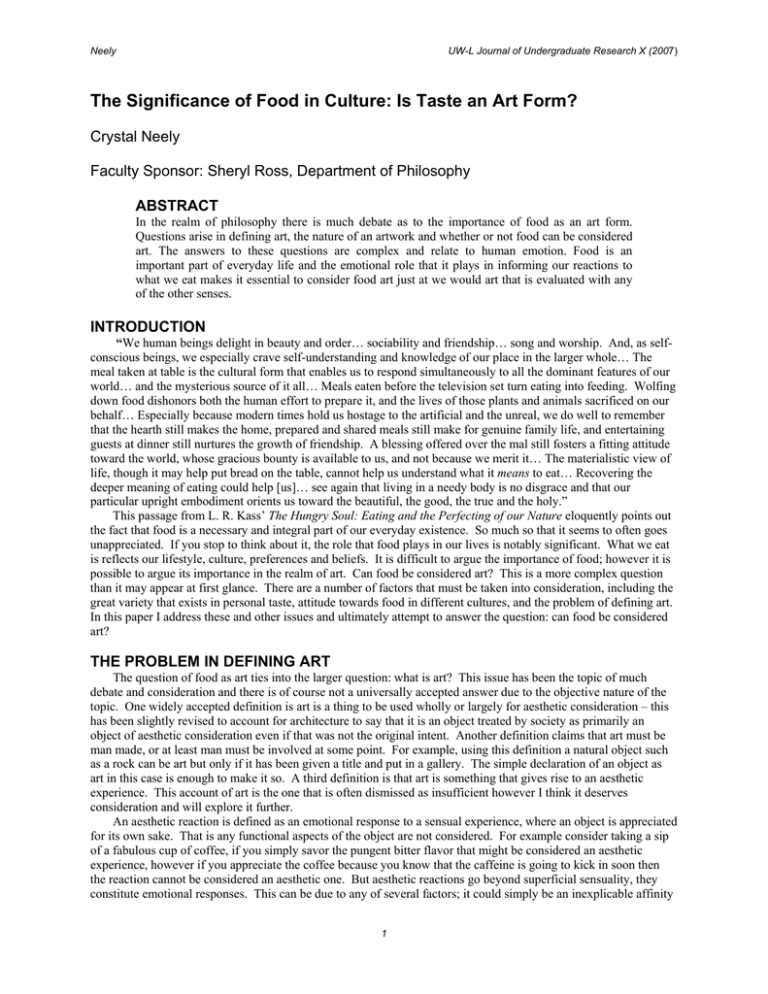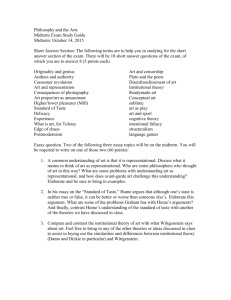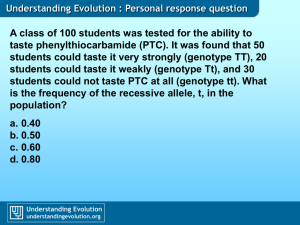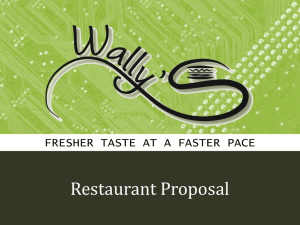The Significance of Food in Culture: Is Taste an Art... Crystal Neely Faculty Sponsor: Sheryl Ross, Department of Philosophy
advertisement

Neely UW-L Journal of Undergraduate Research X (2007) The Significance of Food in Culture: Is Taste an Art Form? Crystal Neely Faculty Sponsor: Sheryl Ross, Department of Philosophy ABSTRACT In the realm of philosophy there is much debate as to the importance of food as an art form. Questions arise in defining art, the nature of an artwork and whether or not food can be considered art. The answers to these questions are complex and relate to human emotion. Food is an important part of everyday life and the emotional role that it plays in informing our reactions to what we eat makes it essential to consider food art just at we would art that is evaluated with any of the other senses. INTRODUCTION “We human beings delight in beauty and order… sociability and friendship… song and worship. And, as selfconscious beings, we especially crave self-understanding and knowledge of our place in the larger whole… The meal taken at table is the cultural form that enables us to respond simultaneously to all the dominant features of our world… and the mysterious source of it all… Meals eaten before the television set turn eating into feeding. Wolfing down food dishonors both the human effort to prepare it, and the lives of those plants and animals sacrificed on our behalf… Especially because modern times hold us hostage to the artificial and the unreal, we do well to remember that the hearth still makes the home, prepared and shared meals still make for genuine family life, and entertaining guests at dinner still nurtures the growth of friendship. A blessing offered over the mal still fosters a fitting attitude toward the world, whose gracious bounty is available to us, and not because we merit it… The materialistic view of life, though it may help put bread on the table, cannot help us understand what it means to eat… Recovering the deeper meaning of eating could help [us]… see again that living in a needy body is no disgrace and that our particular upright embodiment orients us toward the beautiful, the good, the true and the holy.” This passage from L. R. Kass’ The Hungry Soul: Eating and the Perfecting of our Nature eloquently points out the fact that food is a necessary and integral part of our everyday existence. So much so that it seems to often goes unappreciated. If you stop to think about it, the role that food plays in our lives is notably significant. What we eat is reflects our lifestyle, culture, preferences and beliefs. It is difficult to argue the importance of food; however it is possible to argue its importance in the realm of art. Can food be considered art? This is a more complex question than it may appear at first glance. There are a number of factors that must be taken into consideration, including the great variety that exists in personal taste, attitude towards food in different cultures, and the problem of defining art. In this paper I address these and other issues and ultimately attempt to answer the question: can food be considered art? THE PROBLEM IN DEFINING ART The question of food as art ties into the larger question: what is art? This issue has been the topic of much debate and consideration and there is of course not a universally accepted answer due to the objective nature of the topic. One widely accepted definition is art is a thing to be used wholly or largely for aesthetic consideration – this has been slightly revised to account for architecture to say that it is an object treated by society as primarily an object of aesthetic consideration even if that was not the original intent. Another definition claims that art must be man made, or at least man must be involved at some point. For example, using this definition a natural object such as a rock can be art but only if it has been given a title and put in a gallery. The simple declaration of an object as art in this case is enough to make it so. A third definition is that art is something that gives rise to an aesthetic experience. This account of art is the one that is often dismissed as insufficient however I think it deserves consideration and will explore it further. An aesthetic reaction is defined as an emotional response to a sensual experience, where an object is appreciated for its own sake. That is any functional aspects of the object are not considered. For example consider taking a sip of a fabulous cup of coffee, if you simply savor the pungent bitter flavor that might be considered an aesthetic experience, however if you appreciate the coffee because you know that the caffeine is going to kick in soon then the reaction cannot be considered an aesthetic one. But aesthetic reactions go beyond superficial sensuality, they constitute emotional responses. This can be due to any of several factors; it could simply be an inexplicable affinity 1 Neely UW-L Journal of Undergraduate Research X (2007) for something, or it could be an emotional response that is tied to memory. With regards to the inexplicable affinity let me clarify. I’m sure you have all heard some variation of a cliché referring to “moments that take your breath away.” These are the times when you feel as if nothing could ever equal what you are experiencing at that moment. Whether it be standing at the top of a mountain drinking in the beauty of nature or taking a bite of a sumptuous meal. You cannot necessarily pinpoint where the joy is coming from but it is real and pure. The second type of aesthetic experience is more predictable, and arguably less intense. It is one where the object in question holds some intrinsic value to the person appreciating it. It could be a work of art that she has spent years studying so the pleasure comes from recognizing the nuances in shading, or a piece of music that she grew up with, or a dish of food that brings with it warm memories of moments shared with family. These types of aesthetic experiences are, I believe central to defining art. It is the connections we make with objects that allow us to appreciate what it is. It seems however that an aesthetic experience is not alone enough to constitute a work of art. Otherwise the mountain I mentioned earlier would be art. In fact it is possible that there would be precious few things not considered art by at least someone. In the interest of moving forward with this discussion I will propose this working definition: art is an object created with intent to give rise to an aesthetic experience and which in some case successfully achieves this objective. THE PARADOX OF TASTE Even if it were the case that there was a universally accepted definition of art problems would still arise in judging works of art and deciding what constitutes art due to discrepancies of taste. David Hume addresses this problem in his “Of the Standard of Taste.” Hume points out that taste varies from individual to individual. He states that this is an obvious phenomenon but the explanation as to why is far from obvious. He raises questions concerning the judgment of quality (which translates into what can be considered art) based on the fact that humans by nature have differing opinions. He goes on to argue a solution to this problem however; his argument leaves room for new problems to arise. Hume opens by stating that there is great variety in taste, and one need only look around to notice this phenomenon. The curious thing, he notes, is that on the surface people agree on the same values; that is most of us agree that elegance, simplicity, etc are qualities to be praised whereas coldness and chaos are properties that we dislike. Tying this specifically to food, it seems that sweetness and saltiness are qualities that we tend toward and bitterness away from. The question that is then raised is: How, if there is seemingly this unanimity in values is there such discrepancy in taste? Hume goes on to state that there are two opposing reactions to anything, sentiment and judgment. Sentiment is a strictly an emotional response by the viewer and therefore can not be wrong. Contrastingly a judgment can be evaluated and rated against others as better or worse. Hume states that it seems only natural for us to seek a “standard of taste,” a set of rules by which we can concretely define the quality of an object as good or bad. But who is qualified to lay the groundwork to establish this standard? Whose judgments do we rely on? It is human nature to assume that our opinions are correct and although with regards to taste we may feel justified, a person with an opposing view will feel the same conviction about his own viewpoint. This problem is the paradox of taste. In presenting a solution to the paradox of taste Hume outlines several factors that must come together to improve taste and make a person able to be a true judge of art. First strong sense, a person must not have compromised senses, so it can be argued that the colorblind person will never be able to present a sound, tasteful judgment of certain art forms. Not all situations of this kind are permanent, for example person with a cold may not be able to fully appreciate a meal because of impaired sensitivity of taste. The second requirement is delicacy, in this case referring to the ability to pick out and appreciate minute details of an object. Hume uses an example from Don Quixote of wine tasting, which nicely illustrates this point. There were two kinsmen called in to taste hogshead which was supposed to be of excellent vintage, one picked out the flavor of leather in the hogshead and the other a faint taste of iron. They were ridiculed until the container was empty and a key with a leather strap was found on the bottom. The fact that the kinsmen each noticed a taste in the wine that others could not pick out demonstrates delicacy of the palate. This story also ties into the third requirement which is practice, if the kinsmen had not tasted many wines they would not have been able to notice the flavors of leather or iron in the hogshead they were sampling. In any aspect of art in order to be able to develop a valid opinion one must have a base of experience from which to draw upon. With this foundation he can then move on to the fourth criteria, comparison of art pieces. Measuring one directly against another will make it possible to notice the strengths and weaknesses in both pieces. The final factor that comes into play, or more precisely must not come into play is prejudice. Hume maintains that in order to present a sound tasteful argument he can not consider anything about the art except the art itself. The background of the artist or predispositions of the judge cannot factor into making a conclusion or the judgment will not be a high-quality one. 2 Neely UW-L Journal of Undergraduate Research X (2007) With these five criteria (strong senses, delicacy, practice, comparison, and freedom from prejudice) it is extremely difficult to attain superior taste as it is defined by Hume. Thus he maintains that there are few qualified judges but that the critique of these few is the true “standard of taste.” Hume seems to be conceding that there is an ideal judge but that really one who meets all these exact standards does not actually exist. Especially because he acknowledges that natural differences (he mentions age and culture) and morals are factors that cannot be changed in a critic so the standard will always be somewhat subjective. So it seems that although there are laid out an ideal set of criteria to judge art the problem is finding a competent judge. THE ROLE OF HUMAN EMOTION IN ART An objection I have to Hume is that he places art in an unattainable place for the common person. It is not possible to separate judgment in the manner that Hume sets out, although his criteria seem a legitimate starting ground. I disagree with the idea that the appreciation has to be a highly calculated process. He comes close to a more plausible case at the end of his essay when he mentions that cultural and moral factors will always come into play in the evaluation of art. This is a phenomenon that in my view is essential not only in evaluating art but is a necessary part in the very existence of art. The role that culture plays in shaping the people we become is immense. Our beliefs are shaped from a young age and depend greatly on what we are exposed to. Religion, or lack thereof, racial background, and family traditions all play a large role in shaping our social, political, and moral views. Furthermore it informs our taste. Different cultures have different forms of art that are unique to them. Although people outside of that culture may be able to appreciate and enjoy that art there will be an emotional tie to ones own form of cultural expression that is lacking in an outsider. The reason art id developed is in order to express some emotion, often this manifest itself as cultural pride. Tradition plays a role in shaping art. Even in art that is stated to be a rebellion, something happened which made the artist want to rebel. What this pride boils down to is emotion. If human emotion didn’t exist there would be no need for art, art is an expression of emotion above all and a way to share that with others. FOOD AS ART At this point I have clearly if not directly laid out my stance on the position of food as art. The tie that food has to human emotion and culture is necessary and integral to it’s consideration as art. The fact that one can eat a meal and have associations with that food that cause aesthetic experiences, according to my definition make food art so long as that was the intent of the preparer. At this point let me specify a little about intent because I’m sure that as my grandmother is cooking Thanksgiving dinner she is not considering aesthetic reactions. However I am also sure that she is thinking about making the dinner a positive experience for her family, so there is in fact intent. This holds true at simple family gatherings and in high cuisine restaurants. Although the level of complexity may vary the basic experience is the same. At this point I feel it is important to address some of the objections that have been raised to food being considered art. The first objection that I ran across is that food is functional and therefore cannot be considered art. This is basically saying that because food has nutritional value it cannot be art. In refuting this statement I will refer to Carolyn Korsemeyer’s book Making Sense of Taste: Food and Philosophy. Korsemeyer claims that the functionality of food is not necessary to the appreciation. The example she uses is wine tasting. At prestigious wine tasting events where connoisseurs gather for the purpose of appreciating wine none is actually consumed. After evaluating the wine it is spat out. Although this is clearly not the case with the majority if eating, it demonstrates that functionality can be separated from aesthetic appreciation. A second argument that has been raised against food as art is that in order to appreciate art there needs to be some level of distance. The physicality of the act of appreciating food violates this distance and therefore food cannot be considered art. In refuting this I will simply refer back to my previous statements. In my opinion the physicality of the act only brings the emotional appreciation nearer and enhances the experience. Another argument that has been raised regards the fact that in general philosophical thought has laid out a hierarchy of the senses, in which sight and hearing rank most important, followed by touch, and smell and taste are judged to be inferior. The argument that is made to support this position ties back to the previous objection: the claim is that because of the physicality of the act, eating lacks the refinement afforded to the appreciation of objects through sight and hearing. Also it is argued that the palate is not complex enough to be able to evaluate food as completely as forms taken in through the higher senses. I judge these statements to be incorrect. Although it may be more difficult to distinguish the formal qualities experienced during the enjoyment of a prepared meal that say, listening to a piece of music, it is entirely possible. In the judgment of any art form experience is required to judge the complexities and quality. To 3 Neely UW-L Journal of Undergraduate Research X (2007) the untrained ear to sound exactly the same just as easily as two glasses of wine could taste the same to the untrained palate. The last and in my mind most interesting objections are questions raised about what actually is a work of art when considering food. Is the work of art the actual dish? If so the inherent transience would to some make it seem that it could not be art. To some art is an institution, something that withstands the test of time. So how could something by which the very act of appreciating it destroys it be art? Is it possible then that the work of art is not the actual dish but the recipe? The objection to this claim is that there is no way for an exact experience to be duplicated thus no way for the art to be reevaluated. These are interesting questions to consider but not necessarily unique to food. Consider a musical composition; are the written notes on the page art? The intuition is to assume no, it is the actual music that is art, but is not every performance slightly different? For that matter can any experience be truly duplicated even with something as concrete as a painting? Again the discrepancies of individual taste come into play. So although the questions regarding the ontological status of food as art may be valid, they are not unique to food and therefore not sufficient to dismiss it as an art form. I see one underlying problem with all the arguments against food as art. These claims tie back to what I have said before. Art is something that is too often “put on a pedestal” too many people seem to think that it is something to be appreciated from afar, and something that only intellectuals can understand. This outlook takes away from what, in my experience, artists are trying to achieve which is an emotional connection with their audience. I will concede to the argument that possibly there can be higher and lower forms of art if being evaluated by complexity and timelessness. However with regards to importance I feel there is only one category because it is impossible to rank the importance of the emotion of the creator or the person appreciating the art as higher or lower than someone else’s. There are two necessary components to art. The first is human emotion; it is in fact the basis of why are exists. Food ties closely onto art because of the close cultural connections that we make with what we eat. The feelings of nostalgia, security, closeness, and comfort brought about by a meal are sufficient to make food art so long as it meets the second criterion which is intent. There must be some attention to detail in the preparation. This ties into the definition of art, if the preparation is not an expression by the preparer but is simply incidental the basic criteria for art is not met. So can food be considered art? If it meets these criteria, yes. REFERENCES Hume, D. 1757. Of the Standard of Taste. Public domain essay. Kass L. R. 1994. The Hungry Soul: Eating and the Perfecting of Our Nature. Macmillan New York. 228-231pp. Korsemeyer, C. 1999. Making Sense of Taste: Food and Philosophy. Cornell University Press New York. Telfer, E. 1996. Food for Thought: Philosophy and Food. Routelede New York. 4





